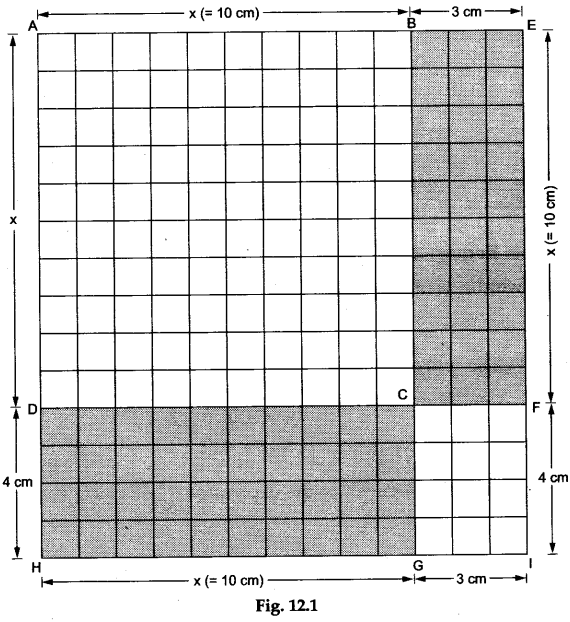Math Labs with Activity – Interpret Geometrically the Factors of a Quadratic Expression
OBJECTIVE
To interpret geometrically the factors of a quadratic expression of the form x2 + bx + c
Materials Required
- Two sheets of graph paper
- A geometry box
Theory
The polynomials (x + p) and (x + q) are the factors of a
quadratic expression x2+bx + c if p + q=b and pq = c.
Procedure
For convenience, we take x = 10.
Case I – Let us first consider the expression x2 +7x+ 12. Then, b =7 and c = 12
Step 1: Find two numbers such that their sum is 7 and their product is 12. Two such numbers are 3 and 4.
Step 2: Construct a square ABCD having each side = x (= 10 cm) on a graph paper as shown in Figure 12.1.
Step 3: Construct a rectangle BEFC having sides BE=CF = 3 cm and BC =EF = x (= 10 cm) as shown in Figure 12.1. Shade the rectangle BEFC.
Step 4: Construct a rectangle DCGH having sides DC =GH = x (= 10 cm) and DH =CG =4 cm as shown in Figure 12.1. Shade the rectangle DCGH.
Step 5: Construct a rectangle CFIG having sides CF =GI = 3 cm and CG = FI = 4 cm as shown in Figure
Step 6: Record your observations (see Observations and Calculations, Case I).

Case II – Let us now consider the expression x2 -x -12 Then, b = -1 and c = -12
Step 1: Find two numbers such that their sum is -1 and their product is -12.
Two such numbers are -4 and +3.
Step 2: Construct a square KLMN having each side = x (= 10 cm) on the second graph paper as shown in Figure 12.2.
Step 3: Construct a rectangle QLMP (inside the square KLMN) having sides QL = PM = 4 cm and sides LM=QP = x (= 10 cm) as shown in Figure 12.2. Shade the rectangle QLMP.
Step 4: Construct a rectangle NMRS having sides NM = SR=x (= 10 cm) and NS=MR = 3 cm as shown in Figure 12.2.
Step 5: Mark a point T on the line SR so as to get a rectangle PMRT having sides PM=TR= 4 cm and FT = MR = 3 cm as shown in Figure 12.2.
Step 6: Record your observations (see Observations and Calculations, Case II).

Observations and Calculations
Case I – In Figure 12.1, we have
- Area of the rectangle AEIH=(x + 3)(x+4) cm2.
- (a) Area of the rectangle ABCD = (x2) cm2.
(b) Area of the rectangle BEFC = (3x) cm2.
(c) Area of the rectangle DCGH = (4x) cm2.
(d) Area of the rectangle CFIG = 3 x 4 = 12 cm2.
area of the rectangle AEIH=(x2 + 3x + 4x+12) cm2. From (i) and (ii) we get
(x + 3)(x + 4) =x2 + 3x + 4x +12 => x² +7x + 12 = (x+3)(x+4).
∴ (x + 3)and(x + 4)are the two factors of x2+7x + 12.
Case II – In Figure 12.2, we have
- Area of the rectangle KQTS = (x-4)(x + 3) cm2.
- (a) Area of the square KLMN=(x2) cm2.
(b) Area of the rectangle QLMP =(4x) cm2.
(c) Area of the rectangle NMRS = (3x) cm2.
(d) Area of the rectangle PMRT = 3 x 4 = 12 cm2. area of the rectangle KQTS = [area (square KLMN) – area (rect. QLMP) + area (rect. NMRS) – area (rect. PMRT)]
=(x2-4x+3x-12) cm2.
From (i) and (ii) we get
(x-4)(x+3) =x2-4x+3x-12 => x2-x-12 = (x-4)(x + 3).
∴ (x-4) and (x + 3) are the two factors of x2 -x-12.
Result
The method discussed above gives the geometrical interpretation of the factorisation of a quadratic expression of the form x2 +bx + c.
Remarks: The teacher must ask the students to factorise other quadratic expressions of the form x2 +bx + c. The value of x may also be taken to be other than 10 cm.
Math Labs with ActivityMath LabsMath Lab ManualScience LabsScience Practical Skills